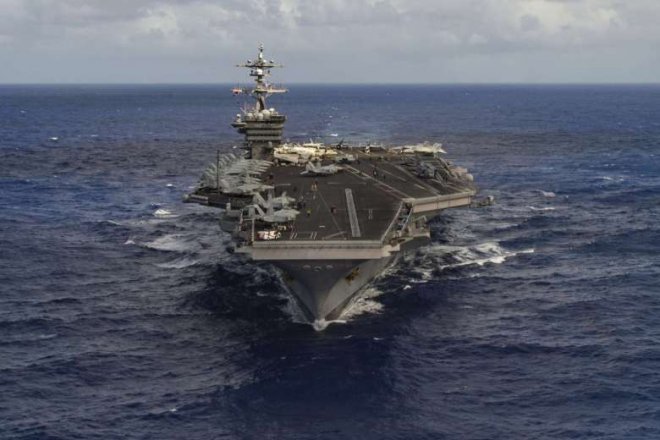
Japan has teamed up with the US Navy and plans to hold joint drills near the Korean peninsula in a military show of force against North Korean threats, reports said on Wednesday. According to two sources, the drills will involve helicopter landings by Japan's Maritime Self Defence Force on each other's ships as well as communication exercises.
A US naval strike force that was led by the nuclear-powered aircraft carrier USS Carl Vinson left Singapore for the peninsula last Saturday, and is expected to reach the Korean peninsula around April 25. The 100,000 ton Nimitz-class vessel is powered by two nuclear reactors and carriers almost 100 aircraft.
"Japan wants to dispatch several destroyers as the Carl Vinson enters the East China Sea," one of the sources told Reuters.
The Foreign Ministry of Japan has also issued a travel notice for all Japanese nationals travelling to or residing in South Korea to pay attention to the situation in the Korean peninsula. However, it stressed that the current situation "does not immediately affect the safety of Japanese".
Lee Duk Haeng, Unification Ministry spokesman of South Korea, said there is no need to worry about security in the Korean peninsula, and that Seoul is working with other governments to manage the tensions.
North Korea has said that the US deployment was "reckless" and it was "ready for war". Hwang Pyong So, the military chief said the country is prepared to "mount a pre-emptive nuclear attack on South Korea and the United States in order to wipe them out without traces if they attempt to launch a war of aggression".
On Tuesday, US Defence Secretary James Mattis said of the deployment: "There's not a specific demand signal or specific reason we're sending her up there."
"She's stationed in the Western Pacific for a reason. She operates freely up and down the Pacific and she's on her way up there because that's where we thought it was most prudent to have her at this time," Mattis added.
Initially, US Navy's Carl Vinson carrier strike group was scheduled to make port calls in Australia. Mattis said: "I believe she was originally headed in one direction for an exercise and we cancelled our role in that exercise."
The Straits Times quotes Defence expert Tosh Minohara of Kobe University as saying that it was "about time" for joint drills between the Japan and US navies. "US and Japan need more operational-level training, and so this is to be welcomed in light of the current security environment," he said.
Meanwhile, this recent display of US-Japan naval power close to China could upset Beijing, which is locked in a territorial dispute with Tokyo in the region over a group of uninhabited islets close to Taiwan in the East China Sea known as the Senkakus or Diaoyu islands.
The Japanese Coast Guard officials said four Chinese patrol ships temporarily entered Japanese waters near the islands on Monday. According to reports, this was the ninth such incursion this year.
Dr. Minohara said that China needs to quickly realise that the joint drills or any other action taken by the US-Japan-South Korea security triangle is "not directed at them but is a direct consequence of them not acting more forcefully towards North Korea".
China is regarded as a major economic benefactor and political ally to the impoverished North Korea, although it has banned all imports of coal from the country until the end of the year.
All these latest developments have been the outcome of the rising tension that was created after the North's ballistic missile launch on Wednesday. North Korea is on a quest to develop a long-range missile that will be capable of hitting the US mainland with a nuclear warhead. Till now it has staged five nuclear tests, two of which were tested last year.
US President Donald Trump, who has said his country is ready to go it alone against North Korea, said on Twitter that Pyongyang was "looking for trouble" and the US would "solve the problem" with or without Beijing' s help.








